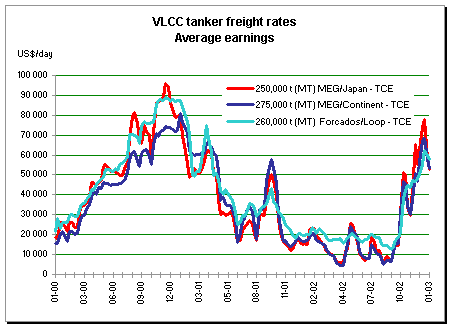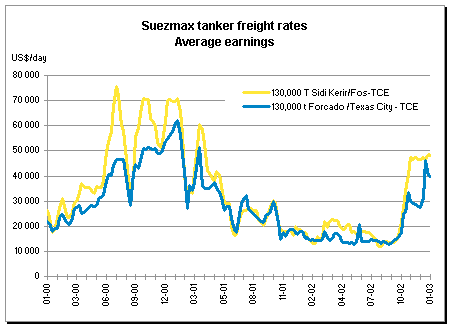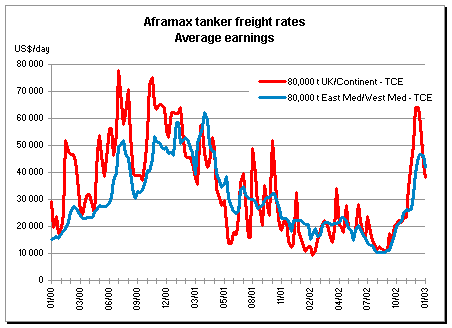
|
The Tanker Market in 2002
|
|
The crude oil transport |
The freight market
VLCC
Suezmax
Aframax
Prospects
The second-hand maket
VLCC
Suezmax
Aframax
& Panamax
Combined
(OBO)
Tomorrow's market
See also: the
product tanker market
|
|
We tried to conclude our last year's report on
an optimistic note by arguing that only a significant economic recovery in the industrialised
countries could reverse the strong downward trend in freight rates. The repercussions of what
we can qualify as after 'Erika' were of a very short duration. The drastic policies put
into effect by the main charterers and importing countries, rejecting the older vessels,
brought in their wake two fierce reactions, which combined to weigh heavily on freight rates.
Numerous (too many?) new orders were placed over the past 3 years. As we shall see later all
sizes were affected, and despite a progressive elimination of the older units, real
requirements and replacement projections have often been surpassed.
Faced with a constant fall in crude oil prices, OPEC members reacted by reducing their
production quotas often by substantial proportions. Apart from a few rare exceptions, it has
become obvious that the world economic climate remains stuck in a prolonged state of apathy.
Hopes of a recovery in the second half of the year, which we alluded to, were not achieved and
the prospects are far from rosy.

The past year has also been marked by a
particularly tense climate in the realms of international affairs. The psychosis of terrorist
attacks following the horrors of September 11 2001 has not abated, and 2002 has seen its share
of bloody events. Closer to us, the attempt which was made on the 'Limburg' demonstrates
that our activity is an easy and symbolic target for the terrorists.
Caught up in this turmoil, which is both geographical and economic, the U.S. has thrown down
the gauntlet against these invisible adversaries by rearranging a part of the reality and in
targeting once again Saddam Hussein and Iraq.
The threat of such a new conflict has had strong repercussion in the oil industry and oil
prices have swung erratically going from under $20 per barrel in January to near $30 per barrel
in September.
|
| The development of freight rates
over the year |
|
|
Generally, as shown in the tables, the drop
experienced in 2001 was accentuated to the mediocre levels of 1999. As will be seen from the
analysis of the different graphs for each of the main sectors, whilst rates collapsed in the
first 3 months of the year, there was a strong rise in the last quarter.
Several factors explain this abrupt and unexpected phenomenon:
-
The threats directed at Iraq have
resulted in a substantial increase in strategic reserves.
-
This is the traditional period of the
year when consuming countries build up their stocks in preparation for a cold winter.
-
At the same time, producing countries
have significantly opened their taps and have exceeded their self-imposed quotas.
Consequently in the period October ' November, OPEC production touched 26.6 million
bpd, a surplus of 2.5 million bpd over the official ceiling.
The question that we will examine after an
analysis by sector is to know whether this breathe of fresh air, which owners have enjoyed at
the end of the year, has a chance of being extended and confirmed, or whether it is simply a
short-lived illusion.
The catastrophe of the 'Prestige' nearly three years after that of the 'Erika' and its
consequences, will help to highlight some of the parameters and conclusions, which we shall try
to draw from all this.
|
|
|
|
Particularly sensitive to the uncertain
climate we are currently experiencing, this category of tankers, with the exception of the
fourth quarter, had a very difficult year. The export restrictions imposed by the Gulf
producing countries, together with a high level of new deliveries, resulted in an
imbalance of supply and demand particularly detrimental to owners. Voyage returns
continued to plummet to reach in certain cases levels lower even than those in 1999'
($5,000 to $6,000 per day).

Given these circumstances and without any
expectation of an economic recovery in the short term, many owners of older vessels
decided not to hold on, and sent their units to the scrapyards. A total of 41 VLCC /
ULCC(1) were taken out of the fleet in 2002 compared to 40 in 2001 and 29 in 2000.
At the same time, 40 new vessels were delivered in 2002, thereby balancing the fleet
withdrawals. Nonetheless we have been able to observe that the increase in voyage demand
at the end of the year has had an immediate effect on rates, and shows the very fine
balance between supply and demand with Worldscale rates doubling within a few weeks!
Thus during the last quarter, Worldscale levels reached their peak (WS 120 / 130) for
short voyages to the East and WS 107,5 / 110 for longer voyages to the U.S. Lucky owners
have been able to benefit from returns unthinkable throughout the first three quarters,
which often exceed $60,000 per day.
Another reason for the additional volatility of this market is that, apart from the
traditional traffic out of the Middle East Gulf, an increase from other sources notably
West Africa has developed. Thus in this zone, which up till now saw the Suezmax playing a
dominant role, there has been an increase in combining stems for VLCC's.
There is also an expanding share of traffic towards the Far East, which confirms a trend
towards shorter hauls that affects the global tonnage demand.
As to owners' situation, already alluded to in our last report, the policy of forming
'commercial pools' chosen by some in the lean periods, has come under pressure
following the poor levels being obtained in the period up until September. Consequently we
have seen the departure of Frontline from the Tankers International pool. As this is one
of the leading VLCC owners in the world, it has to be admitted that there are difficulties
and limits of such a policy in a declining market.
|
|
|
|
The results of the past year are similar in
all respects for this category of tankers to those of VLCC's.
After 2001, which despite its ups and downs was on the whole positive (with average
returns close to $30,000 per day), owners were unable to resist the gradual deterioration
of the overall economic conditions. Whilst the levels and returns did not fall to the
depressed levels of 1999, there was nonetheless a steady decline from January to September
2002.

As with the VLCCs and for the same reasons,
the last quarter saw a jump in levels as abrupt as it was excessive, and unjustified by
the fundamentals of the market.
Even more than the previous year, it was the Mediterranean which was the main spur of this
market. Russian exports now play a major role, together with the constant flow of liftings
from the Sumed pipeline and in 'normal' times, Iraq crude exports out of Ceyhan.
With respect to Russian Black Sea liftings, the new Turkish regulations introduced at the
end of the year (with the Dardenelles transit only permitted in daylight hours) these add
at least another two days to voyage times. With an ever-increasing rise in traffic, there
are real jams, which can double the theoretical transit time. This simple measure
naturally affects tonnage availability and helps push rates higher.
As already mentioned, West Africa is in the process of losing its position as a driving
force, even though it still represents an important share of the global traffic,
especially towards the U.S.. On this route the average rate experienced this year was
around WS 78,5 compared to an average in 2001 close to WS 110.
During the first nine months of the year, with the exception of a slight hike in June,
returns remained below $15,000 per day. Proof of the predominant influence of economic
events on rates, this size of tankers has remained globally balanced in terms of numbers
for many years. Thus since 1998, 106 new units (15,9 million dwt) have been delivered
while 107 (14,7 million dwt) have been scrapped.
2002 however differed slightly from preceding years with 25 units delivered as compared to
only 15 ships withdrawn from the fleet.
Another important phenomena in relation to previous years was the conversion of units
destined to the offshore market being more favourable to VLCC than to Suezmax.
Consequently only 2 old Suezmax were converted in 2002 as compared to half a dozen VLCCs.
|
|
|
|
Freight rates for this size of tankers have
not deviated from the overall tendency with a market in steady decline since the beginning
of 2001, up until the notorious jump during the last quarter of 2002. Nonetheless in
contrast to the larger sizes, the lowest levels registered this year did not reach the
abyss of 1999 when returns were frequently below $10,000 per day.

This ability to absorb the impact of the
economic crisis is largely explained by the great flexibility that this category of ships
possess.
Within the European and American zones, traffic is extremely steady, but it only requires
a minor movement in the supply / demand equation to produce a sizeable change in rates.
Thus the North Sea and Caribbean markets were true to form with wild rate variations,
notably in the North Sea with the traditional bunching of liftings at the end of the
month.
However generally speaking, levels remained fairly mediocre form January to September: WS
103 for inter North Sea voyages, WS 109 for cross Med and WS 123 for Caribs / U.S.
The last three months of the year, but especially November and December, allowed owners to
rapidly get out of this depressed state and to obtain steadily improving levels. In Europe
returns on modern units often surpassed $40,000 per day. The Caribbean market was
comparatively less favourable.
The crisis that shook Venezuela in December produced an abrupt reduction in demand and
owners quickly had to accept lower rates.
As we have seen earlier in our analysis of the Suezmax size, the Mediterranean market was
also strongly affected and perturbed by the restrictive Turkish measures in respect of the
Black Sea traffic. The difficulties encountered during the transit of the Dardenelles and
the Bosphorus have and will increasingly affect the tonnage availability.
|
|
|
|
At the time of writing, the impact of the
'Prestige' shipwreck is naturally very much in our minds. Politicians as well as
others, both in Europe and in the rest of the world, affected by the dramatic consequences
of such a pollution are trying to adopt drastic and rapid measures.
Preventing old single-hulled tankers from carrying fuel oil or even crude is purely a
political decision aimed to satisfy public opinion. Although it is common sense, it does
nothing to solve the maritime risk. Whilst it reduces it, nothing stops the possibility of
seeing a 12 years old double-hulled tanker having a similar accident, having passed
through several hands and being poorly or badly maintained.
For several years the Majors have already put in place a system of strict vetting and only
certain less scrupulous charterers are satisfied with vessels that fail this test.
A proper reinforcement of port controls and of objective criteria adopted by both
exporters as well as importers, will contribute effectively and efficiently towards the
elimination of the few stray sheep which causes a risk to the whole fleet and destroys its
public image.
|
|
In fact it is not fair to
give the impression that the seas are infested with 'floating rust-buckets', and the
incident of the 'Prestige' is more the exception that proves the rule, at least as far as
European waters are concerned.
Considerable efforts have been made by owners over recent years and the rejuvenation of the
world tanker fleet is today a reality.
As the graphs show, the VLCC and the Suezmax categories have been considerably renewed over the
past four years, as today two-thirds of these fleets are less than 10 years old. Compared to
the end of 1998, the ratio was closer to half.
Only the Aframax size, despite increasing by some 20 new units in the last four years, remains
relatively unchanged in its age structure, with a proportion of nearly 50 % of vessels over 10
years old. Nonetheless it should also be stated that most of these older ships are to be found
East of Suez.
As to the question of freight rates over the short and medium term, once the excitement is over
and the traditional period of winter activity passed, can one expect to see the strong recovery
at the end of the year being maintained?
Putting aside the repercussions of the American intervention in Iraq, one is forced to observe
that the global demand is unlikely to progress significantly over the coming months. The
prevailing economic conditions remain morose in the majority of industrialised countries and
prospects for a recovery are not for tomorrow.
Opec decided in mid-December to reduce its overproduction as from January. This should drop to
23 million b/d with a price target between $22'28 per barrel.

| At the same time the availability of tonnage will
continue to increase and the delivery of new vessels in the coming years indicates that there will
be no shortage of transport capacity.
If one looks at the number of single-hull units one
is forced to remark especially for the Aframax category, that the capability of owners and shipyards
today to react is such, that an imbalance in supply and demand in favour of owners will only be
short-lived.
Thus we believe that the extraordinary increase in
freight rates during the fourth quarter should carry through into the first months of 2003. The
impact of the media with the pollution of the 'Prestige' will reinforce the tendency towards
caution on the part of majority of charterers. A marked preference will be given to the most modern
vessels.
However, without a rapid recovery in the world economy and a lasting effect on the energy
consumption, the risk of collapse is still present. Opec's decision to reduce its production to
levels similar to those of the first quarter of 2002 is further proof of the fragile nature of our
market'
Shipping and Shipbuilding Markets in 2002
I N D E X
|